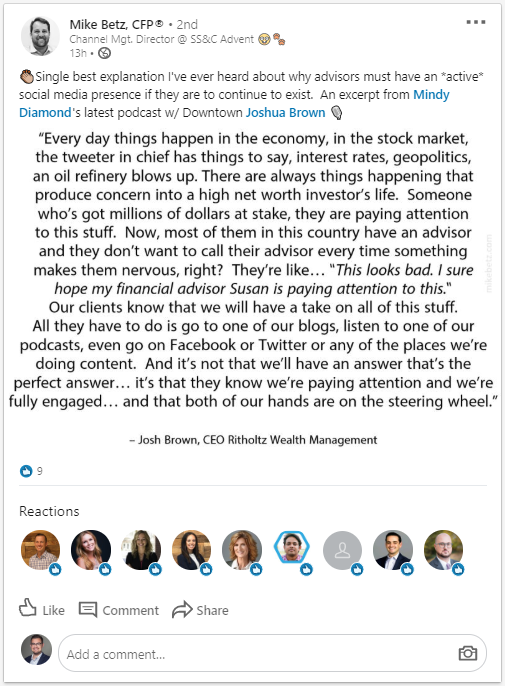10 actionable Twitter strategies for advisors

From creating engaging content to planning creative campaigns, it can feel overwhelming for busy advisors to create an impactful Twitter strategy. The financial world moves quickly, and we need tools in place to help us keep up. When used strategically, Twitter can help advisors stay on top of relevant news, source content to share across their social channels and position themselves as thought leaders in the financial space. The news is significantly more diluted today than it was 20 years ago, and Twitter can help you sift through the noise.
Here are 10 actionable steps advisors can take to effectively use Twitter:
- Establish a documentation process as well as any recommended protocol with your firm’s compliance officer. If you reply to a post with a comment or post content, keep compliance regulations in mind. Likewise, ensure that branding is also up to the firm’s standards.
Remember: Twitter is a visible initiative for your firm, and you want to represent it accordingly.
- Use your feed as an information-gathering tool. 71% of Twitter users get their news from the platform. Twitter can help you find trending news in the industry, both in larger public circles and in the niches you serve. Take note of relevant keywords to research and incorporate into future content. Follow journalists, influencers and active users relevant to your niche. This can help you learn not only what’s newsworthy, but what content is engaging enough to be shared. You can also gather information about what drives your clients. Follow clients and prospects and analyze what content they share.
Pro tip: Make “lists” of people to follow closely.
- Make time for engagement. Share, like and comment on content that resonates with you. A retweet (RT) can go a long way on Twitter. Occasionally, try to add a comment that clarifies your position or opinion when you RT an article.
But don’t just share everything you find interesting. You should be picky about what you share. You should only distribute quality content because your followers form their own opinions about you through what you share. The content that you send out should be in line with your niche, but it should not just be one-directional. Respond to relevant posts from your target audience and current clients to strengthen those digital relationships.
- When posting, go heavy on character and light on sales. Post helpful content, above all else. When it comes to brand voice, remember your firm’s core values and business goals. Channel how you speak to clients and prospects in person and opt for that tone in your posts.
- Include links to your website. Backlinks are important to the overall health of your marketing, whether you’re looking to build authority for your website or increase leads.
- Use images whenever possible. Draw the eye with a nicely-rendered design. Try a mix of still images, GIFs and short videos. Experiment, but do so tastefully within the borders of your brand’s guidelines.
- Consider scheduling. You can compose tweets ahead of time and schedule them via tools like Hootsuite or Buffer. This is particularly effective for campaign planning, as you will be able to get the content reviewed by compliance earlier in your content development. If you go with the schedule-ahead approach, try mixing in some more “natural” tweets that you send out in real-time to keep your voice from sounding too robotic. Sending out all staged content creates a stale brand, and that is something you want to avoid with any social media presence.
- Hashtags are your friends. They should be researched thoughtfully, but used sparingly. Tweets with one hashtag are 69% more likely to be retweeted than those with two hashtags. Try to keep to a relevant few at the end of your tweet, and maybe just one embedded into the copy of the tweet itself. Event hashtags and hashtags for #tweetchats should also be investigated and utilized when appropriate
- Get the team involved. Ask employees to engage with your content. Conversely, share their posts about firm content and their bylined articles. Business handles with dedicated support should engage directly with employees. Larger firms should consider using Twitter as an employer branding tool that promotes your culture and naturally helps with recruiting.
- Analyze and iterate. Discuss what’s working with your marketing, sales and product people and create a regular content review meeting. Twitter users often forget this step. They get so caught up in listening, sourcing content and posting it that they miss the bigger picture. If something is resonating with your audience and consistently gets a lot of engagement, double down on that topic and share related content.
Twitter is a unique social media outlet. It gives advisors a way to monitor the market, stay on top of breaking news, source valuable content and engage with their target audience. When used correctly, it can be the foundation for content shared across all social platforms.
This LinkedIn post from Mike Betz, CFP®, Director of Channel Management at SS&C Advent, confirms how important it is for an advisor to have an active Twitter and social media presence.

Monthly insights from our Chief Growth Officer, Jack Sharry
Get exclusive insights and interviews from around the industry

 By
By 




